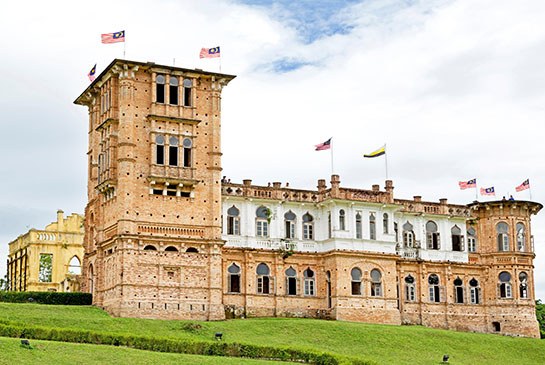5 Incredible Landmarks Built in the Name of Love
by Cindi Sutter, Chief Communicator & Editor of Spirited Table® - Content By Lindsey DeSimone - January 31, 2015
Designed as symbols of undying commitment, these impressive estates around the world hold exceptionally romantic histories
The castle Swallow's Nest near Yalta, Ukraine. Photo: Getty Images
What would you do for love? Some might suggest a bouquet of roses or a strand of pearls. Not these architecture-loving romantics, who went above and beyond to make their sweethearts swoon, building extravagant mansions from Malaysia to Ukraine in the ultimate grand gesture.
Swallow’s Nest Castle in Ukraine. Photo: Givaga/Alamy
A neo-Gothic fortress, Swallow’s Nest Castle sits 130 feet above the waters of the Black Sea. Little is known about the history of the castle, which was built by a German noble in 1912. According to local legend, he visited the plot of land on his honeymoon, which was then occupied by a small wood home, and decided it would be better suited for a romantic castle to be used as the couple’s personal retreat. The sturdy structure has gracefully withstood the elements, including an earthquake in 1927. Today the two-story castle is open to tourists.
New York state’s Boldt Castle. Photo: National Geographic Image Collection/Alamy
Boldt Castle, located on Heart Island in upstate New York, was commissioned in 1900 by George C. Boldt, a wealthy hotelier who built the residence as a symbol of his overwhelming love for his wife, Louise. Just four years after construction began, Louise suddenly died. Heartbroken, Boldt halted work on the castle and never returned to the island. The magnificent structure fell into ruin until 1977, when the property was acquired by the Thousand Islands Bridge Authority, which restored the castle inside and out.
India’s Taj Mahal. Photo: Melissa Maria
During his 30-year reign over India, Emperor Shah Jahan took many wives, but none was as adored as his third, Arjumand Banu Begum, commonly referred to as Mumtāz Mahal, “beloved ornament of the palace.” When she died in 1631, Jahan enlisted a board of architects to devise the Taj Mahal in her honor. The main complex was completed in 1648, and the surrounding buildings and gardens were finished five years later. The emperor spared no expense for the now iconic monument: More than 20,000 sculptors, calligraphers, and craftsmen were brought to the city of Agra to work on the marble-clad masterpiece.
Kellie’s Castle in Malaysia. Photo: Khim Hoe Ng/Alamy
This far-flung estate in Batu Gajah, Malaysia, was devised as a family home by Scottish-born William Kellie Smith for his wife, Agnes, and their young family. The pair married in the early 1900s and moved to Malaysia, where William owned a plantation, and built a small fortune. Legend has it that Agnes was unhappy with their small wood home; to please his pregnant wife, William decided to erect a hilltop castle, reminiscent of those found in their native country. When he died unexpectedly in 1926, plans for further construction came to a stop and Kellie’s Castle was abandoned. The government has made efforts to tame the unruly grounds that have since entangled the isolated structure.
The Petit Trianon in France. Photo: Hemis/Alamy
Found on the grounds of Versailles, the Petit Trianon was based on the Grand Trianon, one of the French palace’s most refined landmarks. Erected on orders from King Louis XV, the retreat took six years to build. Intended as a gift for his longtime love and mistress, rococo tastemaker Madame de Pompadour, the neoclassical structure was not completed until 1668—four years after her death. Seven years later, Louis XV’s successor, Louis XVI, gave the Petit Trianon to his controversial and extravagant bride, Marie Antoinette. Wishing to distance herself from the rigid lifestyle of the monarchy, she used the building as her main residence, fully updating the interiors and grounds to suit her personal tastes.






